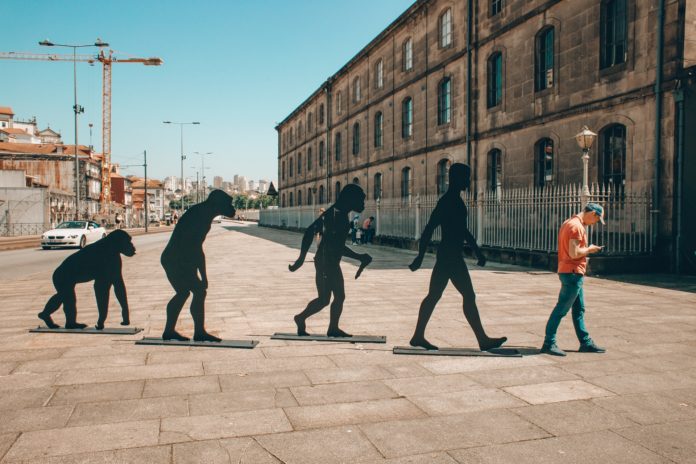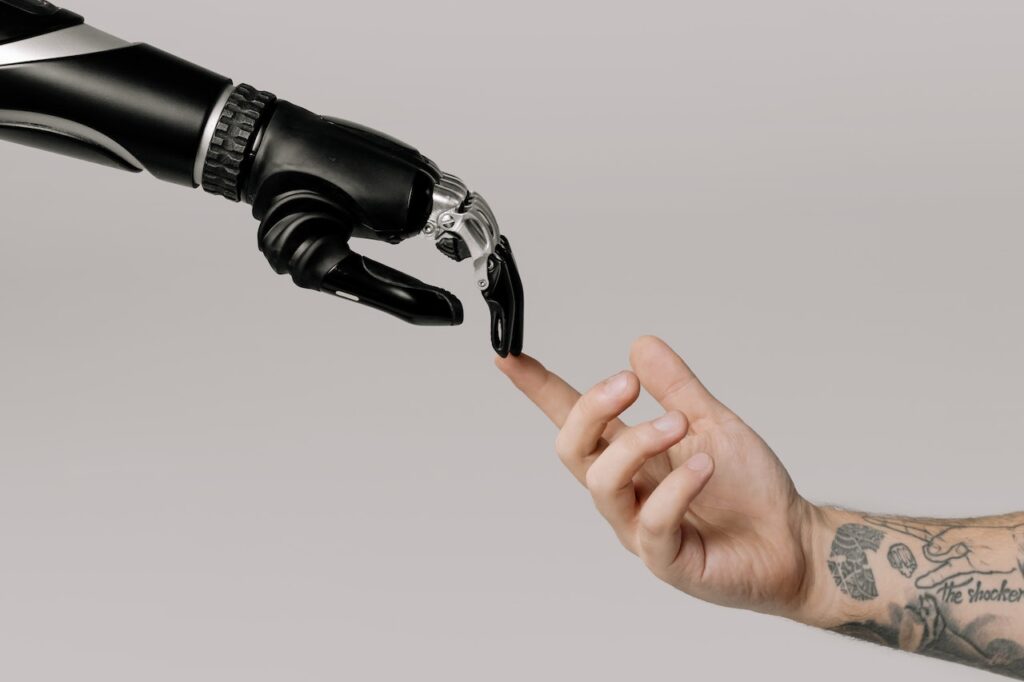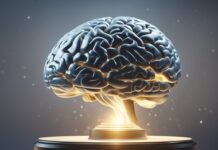
People often like to say how we evolved from monkeys and that monkeys are our great ancestors. Per evolution theory, this is not exactly right, while it has some contextual sense. Namely, different species do not just evolve into other species since the process is much more complicated than that.
Basically, to say that humans evolved from monkeys is like saying that birds evolved from fish. At the same time, it’s ok saying that in a non-formal and non-scientific way, it’s not how evolution actually works.
More specifically, it does not work in such a horizontal way. Besides that, evolution also does not work in a way that always results in the formation of a new species.
Related:
How Evolution Works

What really runs evolution are population dynamics, genetic diversity, and genetic mutations. Of the three, to those untrained in the genetic sciences and fueled by the sensational ideas of popular science fiction, the mutation has tended to surpass the other two, which are the real driving forces without which evolution could not happen.
While macro-mutations such as three-headed animals (tricephalic) do occur, this is not what evolutionary scientists think of as mutation; what they are really referring to are the spontaneous single-gene mutations that throw up an unusual characteristic that may offer a fractional survival advantage or disadvantage. At least, this is how much we know with current science. Perhaps we’ll think about it in a different way in hundred years.
Nevertheless, for now, mutations are really just an influence; because populations tend not to breed far outside their immediate environment, mutations help to restore genetic diversity to what otherwise might become an overly homogeneous genetic pool.
So, to demystify the question at the beginning of this post without delving into deep phrases of evolution theory, we could conclude that humans developed over many millions of years from early ancestors that were like apes. That is, humans did NOT evolve directly from apes.
Instead, humans and apes both developed from the same anthropoidal (apelike) ancestor. The ancestors of humans became separate from the ancestors of apes somewhere around 8 million and 5 million years ago. After that, each group developed completely on its own.
Nevertheless, modern humans and apes are still closely related. In fact, most scientists believe that humans and great apes (bonobos, gorillas, orangutans, and chimpanzees) belong to the same scientific family unit. Still, there are many significant differences between humans and apes, as we all know.
Related: What Will Humans Look Like In 1000 Years?
Gorillini & Hominini tribes & Human evolution

For this reason, scientists have divided the family into smaller groups. Chimpanzees, gorillas, and bonobos belong to a group called the Gorillini tribe. Orangutans belong to a group called Ponginae. Humans, on the other hand, belong to the Hominini tribe. The term hominin refers to humans and all their ancestors from the time they began developing separately from those of apes. Also, it must be mentioned that Hominini includes the extant genera Homo and Pan but excludes the genus Gorilla.
Now, this is all fun and dandy (perhaps), but does it give us a clue as to where we could potentially evolve many years in the future? Well, not really. But it leaves us with curiosity, speculation, and imagination which is exactly the idea of this blog.
Looking at the problem from an uneducated high-level view, one would think that because evolution has constantly been happening for millions of years, then probably, we are evolving into something. While this can perhaps be true, it is much more complicated.
Humans made it more complicated since we are so widespread in the world, which means that evolution did us good and that no additional genetic mutations are needed for us to thrive on this planet. We are thriving so well that other species are starting to suffer, and because of their suffering, potentially, we will soon also be on the verge of extinction. There have been numerous mass extinction events in the past billions of years that eliminated a significant majority of species. Some died directly because of catastrophic events, and some because their evolution and their mutations were not aligned with the present world.
A good example is the panda population, as their number is constantly decreasing. One of the main reasons that the panda population has declined is environmental devastation. As the human population in China continually grows, the panda’s habitat gets taken over, forcing pandas to live in smaller and, in most cases, less livable areas. Habitat destruction also leads to food shortages for pandas. However, there is also the evolutionary reason. Pandas subsist almost entirely on bamboo. Bamboo contains very little nutritional value, so pandas must eat 12-40kg every day to meet their energy needs.
So, their evolutionary development led them to eat only very specific foods, and if there are shortages of those, well, then they are not in a good place. Imagine what would happen with people if we evolved in such a way that we cannot digest anything but carrots? For sure, we wouldn’t be here in this world anymore, or the whole world would be filled with carrots. But we are here, and we are wondering what will happen with us in millions or billions of years.
Thinking about this topic, I came across weird ideas driven by popular science and movies but let’s try to delve a little bit deeper than Terminator (or any kind of robots) even though this is not something to disregard completely as we simply don’t have a clue.
Human Races & Evolution

Let’s start from the first level, and those are different races of human species today in the world. Looking at the very distant future, could we potentially expect that races will merge into one? This is perhaps an uneducated question but let’s go with it. Today all races are mixing on a daily basis everywhere, and this is great as it wasn’t the case before.
Previously different races of people mainly lived in their area of land and didn’t have the physical possibility to mix with other races. They would need to walk onto other continents or areas of land where other races of humans lived. Then this slowly started to happen, but still, because of some kind of idiotic and completely nonsensical racism, this didn’t happen so often during most of human history. Only in relatively modern history, mixed races couples have become something normal, but there are still places in both developed and an undeveloped world where this is still not tolerated.
Nevertheless, mostly it is, and it will be even more with every passing year. So, in perhaps 100 000 years or perhaps 10 million, there will be one race of people. This is, of course, a long shot, and no scientist would approve of this theory, but we really have no way of knowing what will happen with us in, say, 10 million years.
Remember, Homo sapiens is only on Earth for around 300 000 years. I mean, at least, that is what we think or know based on the latest fossil evidence. Everything can change in the course of Homo sapiens history based on one new piece of fossil evidence that we stumble upon. Nevertheless, let’s continue to indulge the hypothesis of singular race.
So, if there will be one race of people, which one would it be? Probably a mix of all. However, one could also assume that there will be fewer blonde people because of a recessive blonde gene. While this at first seems like a good hypothesis, it has already been proposed and debunked by scientists. Namely, claims that hat blond hair will disappear have been made since 1865.
Those claims can be grouped under the disappearing blonde gene phenomenon. BBC reported in 2002 that unnamed German experts concluded that blond hair would basically disappear within the span of 200 years since blond hair genes are recessive. Everybody knows that children of parents with black and blonde hair will probably not have blonde hair except if a neighbor intervenes. This is because black and brown hair are dominant alleles.
Anyhow scientific community disregarded this story mentioning that it was based on a misinterpretation of recessiveness in genetics. Based on current science, gene frequency is stable unless there is selection for or against them, which does not appear to be the case for blonde hair. In large populations, even exceptionally rare genes will persevere at stable levels over extended periods of time. It also doesn’t matter whether a gene is recessive or dominant.
Genes fade if the population is very small (drift) or if they confer a disadvantage (selection). While blonde hair does not confer a disadvantage, no scientist can know what will happen in millions of years. So, to conclude this first point – potentially, we will have one race of people. Perhaps then we’ll end racism once and for all. So far, so good. But this isn’t evolution per se because we would still be the Homo sapiens, at least assuming this long shot hypothesis. So, moving on to other and weirder ideas on where could we potentially “evolve” in the distant (or even near) future.
Technological evolution

The technological advancement that humans are constantly making is certainly influencing what and who we’ll become. We are continually building new things, more things, better things, and it seems like this is the sole purpose of humanity these days especially. Well, perhaps it is. Perhaps with all those micro advancements over thousands of years, we are unknowingly building Human 2.0.
In one of Joe Rogan’s podcasts, he was ranting about AI and human progress, and something he said aligns perfectly with the analogy I am trying to make here. Namely, perhaps within the context of the evolution of life on Earth, humanity is playing the role of some kind of caterpillar who is about to give birth to the butterfly that is – Artificial Intelligence (AI).
Our desire for the rapid and constant progression of technologies is serving a Darwinian function of survival, one that will lead to a breaking-off point between biological and synthetic life forms. When you really think about it, seems like this is exactly what we’re doing as humanity on this planet.
With constant progress, unavoidably, we will build something that isn’t quite human, but in some ways, it still is. We don’t know now whether this will be some sort of AI connected with our brains or synthetic expansion of our body, but there are clues everywhere. Elon Musk’s Neuralink is hard to avoid here as they are developing implantable brain-machine interfaces. Elon Musk once said that with the implementation of this technology, there is a real chance that humans will not have to speak anymore as we will communicate by reading each other thoughts completely.
Whether this is a good idea or not, we can’t know for now, but it could for cure change the course of human evolution in one way or another. With implants in the brain and synthetic replacements of our body, are we already evolving into something or someone who can not be called Homo sapiens anymore? Who knows, perhaps in 100 000 years, historians will mark 2020 as the first evolutionary evidence of new species called Homo Techiens. But constant technological advancements could also take us into disasters that we cannot even think of.

Seventy years ago, no one predicted the internet and what we will create with it. All futuristic movies, books, and articles delved into something completely different during history, such as flying cars, robots et cetera. Not that we don’t have those in some kind of experimental phases, but they are not so important currently as the Internet is.
The Internet changed every possible thing we can imagine on this planet, some for better, some for worse. So, it is hard to predict what will be the most important technological advancement in the next 1000 years. I mean, as mentioned, no one even predicted the Internet, not even close (ok, to be fair, Marshall McLuhan described something similar in 1962 but not really in a way it is used today), and it has by far the biggest influence on humanity today.
Especially having in mind how fast everything is evolving, particularly in the last 20 or 30 years. This rather fast advancement can be described quite nicely with Moore’s law. Moore’s law simply describes that the number of transistors on integrated circuits doubles on average every two years. This is rather important since the power of computers is thus increasing almost exponentially. The doubling time of computational power and capacity for PCs was 1,5 between the years 1975 and 2009.
Just remember the ENIAC computer, which was the size of an apartment, while today you have much more power in your pocket. It is astonishing yet kind of horrifying. Nevertheless, not all progress is linear as it is with computers. That is to say, we do not see progress every year, but in contrast, one sudden patent can shrink 100 years of development into one year. This non-linearity can be perhaps described with recent findings in the human genome. Let’s mention CRISPR here (clustered regularly interspaced short palindromic repeats).
CRISPR is a rather simple technology as it seems, but it is a fantastically powerful tool for editing genomes. Just imagine what you could do with such a tool if it is widespread and available for every human. It is technologically available already, but still, there are many concerns. For one, you could edit the genomes of your babies so that they do not get cancer, and this is great. But perhaps rich people could also edit genomes so that their children are way smarter and stronger than other children. Well, Huston, then we have a problem. And a big one.
Nevertheless, with all those linear or non-linear advancements, we will almost inevitably “evolve” into a different kind of human being. Will this be a better or worse version of us, time will tell. But such a progression could also potentially lead to the destruction or extinction of human beings (see post about Social Media impact on society). Luckily invention of nuclear weapons didn’t lead to worldwide catastrophic events which would wipe out whole humanity and every living creature, for that matter. Yet. That, however, does not mean that we will not invent something that will destroy us. There are many proponents of Artificial Intelligence (AI), but many opponents also raise concerns about potentially too much power of AI. Nevertheless, there’s one thing that many scientists agree with, and this is that perhaps the most probable “development” in the distant future is human extinction. Whether this happens because of some external event such as a big asteroid hitting the Earth or an internal event such as humans destroying our own habitat, we don’t know, but the probability is high for this kind of scenario, especially if we extrapolate our thoughts into 100 000 years or millions of years from now.
As best we can tell, and it is a very rough estimate, given the limitations of both our knowledge and our evidence (the latter of which, extensive as it has become in the last century and a half since Darwin, is still grossly small) the average span of any particular species (and the definition of such is a subject of much disagreement) is between 3 and 5 million years old. Exceptionally long-lived species may go 10 million years (and of all the orders and families in taxonomy – turtles/tortoises of the vertebrates have been the most successful in terms of general longevity of their type or closely related types). That may not be a comforting number for humanity because (depending on how we humans are defined) our oldest, arguable antecedent may be as old as 5 million years already. If, however, we count only our emergence as Homo sapiens, then we are only between 200 and 300 thousand years old. So, we do not really know if our group is in its senescence, its “final stage,” or freshly sprung and with a grand future before us. And so, one of perhaps most probably next evolutionary steps for Homo sapiens is extinction. But what else do we have? Can we expect some kind of mutations, enlarged or smaller parts of our bodies? The first question that comes to mind while mentioning this topic is – the size of our heads & brains, and are they getting bigger?
Beginning with the dawn of the first Homo species, human heads evolved to be progressively bigger until around 30,000 years ago, when head size plateaued. We actually don’t know why size plateaued. But we do know that about 6,000 years ago when agriculture took off, skulls began shrinking. The cause of the shrinkage is also a mystery, but scientists have cautiously agreed that more efficient brain wiring can be tied to easier access to food and safety. This again connects to the idea that people no longer had to be so resourceful and intelligent to survive (Idiocracy rings a bell?).
Physical changes?

In either direction, heads or brains getting smaller or getting bigger, we don’t have enough data to predict what will happen in 100 000 years with our bodies. We could expect that size of the human body will be somehow smaller or less muscular, and this is because so many people live 100% sedentary life. This trend of not using muscles at all could even increase in the coming years with the explosion of virtual reality, online shopping, and online everything. Sex robots, could potentially represent the main trigger in shifting paths of human evolution. If most of the population gets addicted to sex robots, this will surely impact our population curve and thus also our evolution in the long run. Could this “phenomenon” also impact the size of sexual organs? We don’t know, but it is fun contemplating the idea. Just imagine humans in the year 4023 constantly sitting at home making love with their sex robots, whether those are physically present or virtually but completely realistic and available on demand.
Somehow related or perhaps unrelated, but worth mentioning here is the rise of the transgender community. Let’s just indulge the idea that a significant proportion of humans decide to be transgender. How will that impact our population and evolution? Will we become completely asexual and non-fertile in the future? Well, the possibility is there for sure. And so, I digress here on human sexuality, and while it is a rather important part of life, again, we can’t be sure how it will evolve (or devolve) in thousand years, but it is fascinating to wonder.
Moving on to a more scientifically backed approach. With recent advancements in DNA techniques, we have some real proof of what has been happening in an evolutionary sense for the last thousands of years. By using those DNA techniques, we found out that perhaps the rate of human evolution is actually increasing. Namely, we underwent the most dramatic changes to our bodies when our species first appeared. Similarly, in modern times it is clear that we as a species are showing genetically induced changes to our physiology.
Some clues to confirm that can be seen in the fact that human races around the world are becoming more rather than less distinguished. This obviously contradicts my imaginary hypothesis that perhaps in 10000 years, we will all be (mostly) the same race. Yet again, as we can see, evolution does not follow some linear or even logical path. Everybody would have thought that naturally, our heads and brains would become bigger while the opposite is happening. So, the same analogy can be drawn with races. Even though some DNA techniques today show that human races are becoming more distinct, this could easily change with some invention or big event which will change the course of evolution. As we know, agriculture had a big impact on how humans evolved. Modern technology as a set of inventions is still in its infancy compared to agriculture, and we have no idea how it will impact us in the long run.
We constantly carry our mobile phones with us and look at them as the most important thing. Some day will they become part of us entirely? Some people say that we are already somehow cyborgs because our smartphones are our prolonged artifact for information and communication. The challenge currently is bandwidth limitation between us and our smartphones. That limitation is represented in our hands and eyes. Think of it as a mouse and keyboard that we use to control our computer. Well, the hypothesis is – one day, we’ll remove that limitation and achieve a complete merger with computers; thus, I/O (Input / Output) bandwidth would become unbelievable. This could be the final trigger for singularity (if it didn’t happen already). Singularity, in this sense, is a theoretical point in time at which technological growth becomes overwhelming and irreversible, resulting in unforeseeable changes to human civilization.
Beyond humanity

Those unforeseeable and overwhelming changes to us, Homo sapiens, could be, as mentioned before, the complete coalescence of biological bodies and computers. In some way, those things are already happening today with experimental implants, which are now used for basic things such as buying stuff in grocery stores.
But advancement in technology and our desire to constantly develop will take it much further. There will be good and wise implementations benefiting the whole society of humans, and there will be greedy, wicked, and weird implementations that could again completely change the course of our evolution.
Which one will win will decide what will become of us in hundreds and thousands of years. No one has even the slightest idea, as no one from 500 years predicted anything similar to what is happening today. Humans are (biologically) the same in that span of time, but almost everything else is different. Even the smaller span of time applies. If you’re in your 30’s just ask your mother or father did they even dream that one day people would willingly upload their pictures to the world so everyone can see them instantly. Or that they would carry some screens with them all the time, having the ability to look at any information possible and watch the weirdest pornography imaginable. Anyone proposing this idea 70 years ago would have been called a crazy maniac.
Well, here we are, while biologically the same, 180 degrees different than our grandparents were. In the next hundred and surely thousand years, we will not be even biologically the same. We can call this evolution, progression, or perhaps digression. Contrasted to previous times, we’ll have all videos and pictures as proof for comparison. This wasn’t the case in any previous millennia.
Of course, if some big disaster doesn’t hit the Earth as it did many, many times in history. Interesting times ahead for humanity, or should I say for beyond humanity.




















